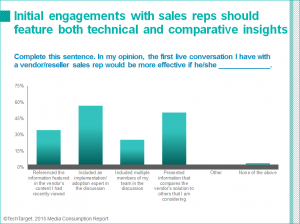- January 19, 2015
- Sales and Marketing Alignment
Redefining Marketing and Sales Engagement
Depending on which marketer you talk to, when it comes to engaging B2B and technology buyers during the buy cycle, they will quote 1 of 4 stats:
- Buyers are 57% through the sales cycle before talking to a sales rep – Corporate Executive Board (2010)
- 67% of the buyer’s journey is now done digitally – SiriusDecisions (2013)
- 77% of buyers don’t talk to sales reps until after they have performed independent research – DemandGen Report (2012)
- 36% of buyers don’t talk to sales until after a short list has been developed – DemandGen Report (2012)
All of these stats undeniably point to buyers’ increased appetite for online content to help inform and educate them about solutions related to their current needs and projects. Also, taken at face value, they seem to marginalize the value of sales within the buyer’s journey.
Death of a salesman?
It would be very easy to look at this list and blame the marginalization of the technology sales rep on the Internet. “They don’t need me, they have everything they need to know about what I am selling.” But it is just not that simple.
B2B and Technology selling is not transactional and it is not done through e-commerce. In what has increasingly become a “necessary evil,” anyone responsible for buying enterprise technology will at some point talk to sales rep. This we all know as fact.
Despite any skepticism that may exist with statistics in the industry – SiriusDecisions has even acknowledged that there is some myth to its findings on the role of sales in the buyer’s journey – it is also fact that buyers are engaging reps later. And the Internet has changed that. Back in the early days of technology buying, the journey started with sales, was led by sales, and ended with sales. Now the only guarantee is that it will end with sales.
But have you considered that the main reason for this phenomenon may have more to do with trust than the tools available to the buyers?
Challenging conventional wisdom
In TechTarget’s most recent media consumption study, 77% of IT buyers say that they would like to engage directly with sales within the first half of the buy cycle. Wait a minute, that doesn’t make sense, does it? That is certainly not what the industry has been hearing the last 4 or 5 years. If they want to engage earlier, then why aren’t they doing it?
The simple answer is trust.
They want to engage earlier, but they don’t trust that they will get useful, valuable, and educational information from sales that will help them make a decision. It’s the same reason I avoid the perfume ladies at the department store, even if I am looking for perfume to buy for my wife. First of all, I don’t want to get sprayed in the face with perfume, but mostly I just can’t trust that I won’t get the “hard sell”.
Consultative, intelligence-based selling gets you in early and helps you win late
Ever heard the expression “you never get a second chance to make a first impression”? Lead early with a hard sell and you will understand very quickly what this means.
No matter how early or late you engage buyers, your first engagement should be about establishing trust with buyers and becoming a valuable resource to them as they try to find a solution to meet the needs of their team and their organization. That being said, according to InsideSales, 50% of sales go to the first rep who contacts the prospect. So you certainly don’t want to wait around with the rest of the pack until buyers are 57%, 67%, or even 77% through the buy cycle.
Getting in early doesn’t always help you close the deal faster, but it does give you the opportunity to shape the deal in your favor.
But how do you build the trust needed to win the deal?
- Do your research – Buyers are doing their research on you – it is imperative that you do their research on them. Your potential customers are way more than just a name on a spreadsheet. Just getting a name and dialing for dollars won’t cut it. Take advantage of the time your buyers spend online by gathering intelligence to help shape when and how you engage them. Understanding how they have interacted with your brand/content, seeing what topics/pain points they research around, and determining what competitors they are looking at will help you read their buying signals and determine their level of purchase intent. This intelligence will give you an advantage when planning how to formulate your follow-up strategies.
- Listen and learn – Successful brands are customer-centric. Listen to the needs of buyers and advise them on how to solve their problems. Help them come to the right decision about your solution rather than leading with it.
- Demonstrate expertise – Technology buyers don’t want middle men. If you are lucky enough to get them on the phone, be prepared to answer their questions with the appropriate amount of technical expertise. If you are not comfortable doing this, bring a sales engineer or technical expert on the phone with you. Buyers are asking for this – and it will go a long way towards establishing credibility with them.
Re-establish the role of sales in the buying process
To channel Mark Twain for a minute, the reports of the death of sales “have been greatly exaggerated.” While the industry talks about the marginalization of technology sales, if reps concentrate on being a trusted adviser for their prospects and customers, their role or importance in the process can never be marginalized.
If you would like to continue the conversation, feel free to leave a comment or connect with me on Twitter or LinkedIn.
b2b sales, Customer Engagement, IT buyer preferences, sales engagements, sales intelligence






